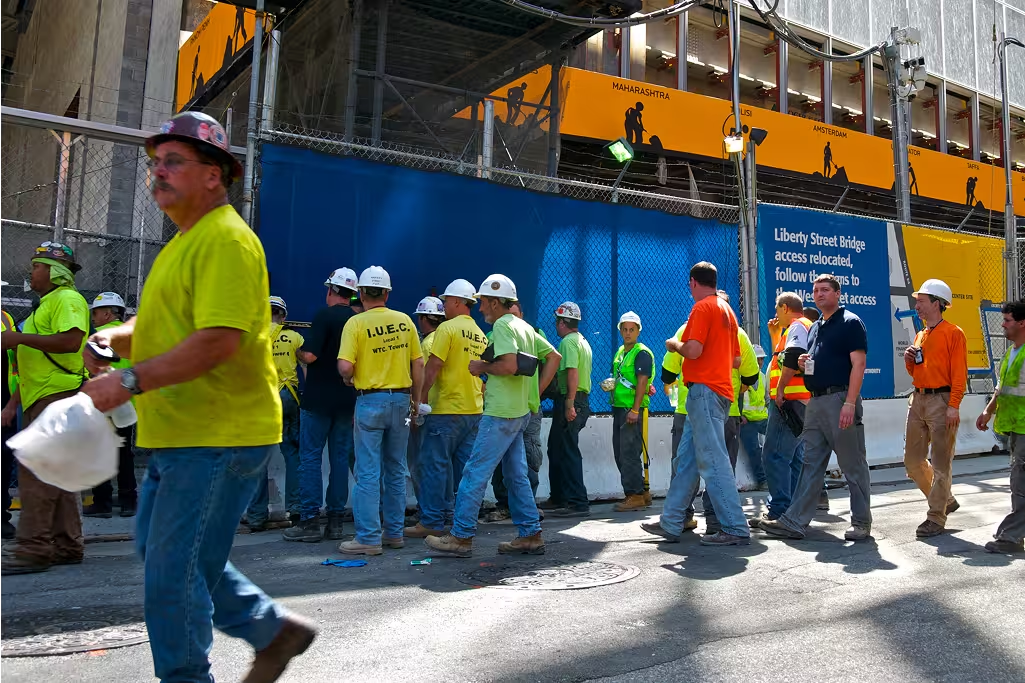Outbuild is online scheduling software to work together on connected project schedules and look-aheads, enabling everyone to move faster.
Key Takeaways
Table of contents
- Understanding the Basics of Gantt Charts
- Key Components of a Gantt Chart
- Step-by-Step Guide to Creating a Gantt Chart
- Tools and Software for Gantt Chart Construction
- Best Practices for Effective Gantt Chart Design
- Common Mistakes to Avoid When Building Gantt Charts
Before a shovel hits the ground on a new construction project, proper planning is needed. Aligning the team and getting agreement on the overall timeline is crucial to success.
Construction is like one big puzzle, with many moving parts that must be carefully managed. Similarly, creating a Gantt chart involves assembling building blocks and requires the planning of many different pieces; think of this as its own kind of construction, Gantt chart construction.
A construction Gantt schedule serves as a visual timeline that outlines project tasks, deadlines, and dependencies. This type of tool helps teams stay on track to meet deadlines – advancing one piece of the puzzle at a time. A proper construction schedule Gantt chart allows team members to organize resources efficiently and monitor progress in real-time.
A Gantt chart is a visual representation, in bar chart form, that helps teams see project phases and how long tasks will take.
It's a crucial component for construction planning and execution, providing a comprehensive overview of a project’s timeline. Knowing how to read and understand Gantt charts is important for anyone in project management as It helps improve communication and coordination among team members.
What is the Purpose of a Gantt Chart in construction?
A Gantt construction schedule helps everyone see a project timeline clearly. It acts as a single source of truth for all team members, helping teams work together to finish projects on time.
By quickly visualizing a project’s work breakdown structure, stakeholders can break the project into smaller tasks. This helps improve clarity, resource allocation, and communication.
Why Use a Gantt Chart?
Using a Gantt chart has several advantages, including the ability to coordinate tasks, track priorities, and allocate resources effectively. It reduces project overlaps and identifies critical paths, minimizing potential delays. Gantt charts are very helpful for keeping a clear view of the project. This is important for making quick, informed decisions.
A Gantt chart for construction project helps create clear timelines. It sets realistic expectations and encourages accountability among team members. Gantt charts are also helpful in managing risk.

How do Construction Team Members Use a Gantt Chart?
Let's dive into a construction Gantt chart example and see how different team members might use it in their work!
Imagine a general contractor is building a schedule for a student housing renovation on an active university campus. Timelines and dependencies are crucial in such a dynamic environment. Here’s how the construction team might engage with the Gantt chart for construction project management:
Project Managers can keep projects on track and effectively allocate resources in real-time with the use of a Gantt chart. For instance, if the plumbing work falls behind schedule, project managers can assess the impact on the overall project schedule, and coordinate with subcontractors to ensure the project gets back on track.
Superintendents rely on Gantt charts to manage day-to-day operations on the site. For example, if framing is done early, they can use the chart to find the next task, like electrical work. This helps the team move smoothly from one job to the next.
Specialty Contractors are able to stay informed of schedule changes through a Gantt chart. If a window installation is delayed until Day 20 because of material issues, other subcontractors can change their schedules. This helps avoid downtime and makes sure they are ready when it’s time for their tasks.
Owner’s Representatives use the Gantt chart to check that the General Contractor follows the timeline. They also coordinate important dates with the university and students. If a delay in the project affects occupancy dates, the representative can use the chart to share and confirm next steps.
Gantt charts help track progress and adjust plans. They also make it easier to share updates. This ensures the project runs smoothly, even with unexpected challenges.
When making a Gantt chart, there are a few important parts to think about: tasks, start and end dates, durations, dependencies, and milestones. These components collectively ensure the chart's effectiveness in tracking the project's progress. Each element plays a crucial role in providing a holistic view of the project’s timeline and requirements.
- Tasks: Clearly defined, individual tasks make it easy to understand what each segment of the Gantt chart represents. These should be named in a concise, yet descriptive manner to convey the scope of work involved.
- Start Date and Finish Date: These dates are the backbone of the Gantt chart, showing when a task is expected to begin and end. Accurate dates are essential for maintaining the project schedule and ensuring timely completion.
- Durations: Each task's duration is shown as a bar on the chart. This gives a clear view of how long each task will take.
- Dependencies: Understanding task dependencies is key to getting the right order of activities. They indicate which tasks need completion before others can start, highlighting the connections between project tasks.
- Milestones: Think of these as major checkpoints or goals in a project that show you're making progress and completing big phases. They're usually marked with a diamond shape so you can spot them easily. Milestones are great for tracking how the project's going and keeping the team pumped up!
Here is a guide to making a Gantt chart for construction project management. We will use the student housing renovation project as an example!
Step 1: Determine the work breakdown structure of the overall project
Imagine this: a general contractor is about to set up their trailer on a busy university campus. Students are rushing to classes and events all around. To ensure that the project runs smoothly, it's crucial that the team breaks the scope into manageable parts, known as the work breakdown structure.
The contractor must break the work into phases with tasks. For example, the Pre-construction phase might include assessing window conditions and estimating replacements. The Construction phase likely consists of adding modern amenities, and the Closeout phase will involve conducting final inspections.
Each step includes activities that help transform old dorms into welcoming, modern living spaces for students. This structured approach ensures that the project progresses efficiently without disrupting campus life.
Step 2: Assign durations and responsible parties to scopes of work
After identifying tasks, the next steps involve setting start and end dates and assigning team members to each task. This process needs teamwork with subcontractors. It also requires knowing material lead times and understanding team capacity. Weather conditions and any special project constraints should be considered as well.
For this particular project, a few project specific considerations come to mind. For example, if the general contractor is informed that the electrical gear is going to have a longer lead time from the beginning, they can build that into the schedule to ensure that final tie-ins and testing are not delayed at the end of the project.
Step 3: Add in critical dependencies or predecessors
Managing dependencies is crucial in planning and scheduling for a student housing renovation. It’s important that work is completed in the right order so that no unexpected delays pop up.
In the student housing project, the general contractor’s laborer cannot install new kitchen appliances until the MEP subcontractor upgrades the electrical system. The painter also cannot start painting the walls until the plumber repairs the leaks in an old student housing building.
Step 4: Plan and manage your schedule and take action quickly
Keeping a construction schedule up to date is crucial in avoiding delays. In a student housing renovation project, finishing on time is crucial for students to move in. It is important to keep the schedule updated so everyone involved is on the same page.
Having an easy-to-access Gantt chart in construction management is critical for successful project execution. It ensures everyone has a clear picture of work status, especially in fast-paced environments.
Selecting the right tool depends on the specific needs and complexity of the project. When choosing scheduling software, you should consider factors such as team size, budget, and integration with existing systems.
Construction scheduling software should be:
- Easy to use
- Allow for scheduling and field planning in one centralized hub
- Integrate with a project management software such as Procore
- Be accessible to trade partners
- Offer great customer service.
This is where Outbuild comes in. Outbuild is a cutting-edge scheduling and planning software solution designed to enhance project management in the construction industry.
As the only platform that allows users to build schedules, Lookaheads, and weekly work plans within one integrated ecosystem, Outbuild offers a holistic approach to project planning. With a focus on Last Planner® principles, Outbuild streamlines workflows and improves collaboration among teams.
The platform provides real-time insights and project analytics through customizable dashboards, empowering construction professionals to optimize scheduling, increase efficiency, and reduce delays. Outbuild's user-friendly interface and robust features make it an essential tool for ensuring projects get completed on time.
Keep it simple and clear. Making a construction schedule too complicated with extra details can make it hard to understand. This can lower its effectiveness as a communication tool.
Keeping a schedule up-to-date is critical to reflect real-time progress and alterations in the construction timeline. Regular updates keep the Gantt chart a reliable source of information and helps project managers make decisions based on data. Communicating with the team is key to understanding what changes you need to reflect in the chart.
Another best practice is to use color coding to enhance the readability of the Gantt chart. Different colors can show different task categories, priority levels, or project phases. This makes it easier to scan and understand the information quickly.
Lastly, use a construction scheduling software that allows you to create an immaculately designed schedule in minutes!

When building a Gantt chart, avoid overcomplicating the task list or neglecting to regularly update the schedule.
You can also follow these steps for scope consolidation (it’s time to transform your 1500 line-item schedule into a streamlined, easy-to-use 50-line item version!):
- Understand your project schedule requirements per your specifications.
- Challenge the status quo. Evaluate the necessity of overly-detailed specifications. For instance, a level 5 schedule might not be essential, or, some details could be more effectively integrated into a lookahead.
- Consolidate your schedule to match the clarified requirements.
- Turn your schedules into Gantt chart templates.
Further, failing to identify dependencies can lead to unrealistic timelines and project setbacks. Always ensure that the chart accurately reflects the project's status and promptly incorporate any changes.
Another common mistake is not involving the project team in the Gantt chart creation process. Involving team members in the planning phase helps make sure all tasks are clearly shown. It also helps find any potential problems early. Collaboration during this phase can lead to a more realistic and achievable project timeline.
Incorporating Gantt charts into construction project management strategies is crucial for maintaining organized, efficient workflows. By following the guidelines and utilizing recommended tools available at resources like Outbuild, teams can effectively manage timelines and enhance project delivery. Seeing the whole project in one chart helps increase productivity. It also creates a team environment where everyone understands the project goals.
Ready to break ground on your construction project management gantt chart? Book a demo or sign up for a 14-day free trial, and see how much easier it is to keep your projects on time with an easy-to-use Gantt Chart software for your construction projects.
Frequently Asked Questions
Related Articles
Ready to see Outbuild?
Join hundreds of contractors from 10+ countries that are saving money by scheduling better










